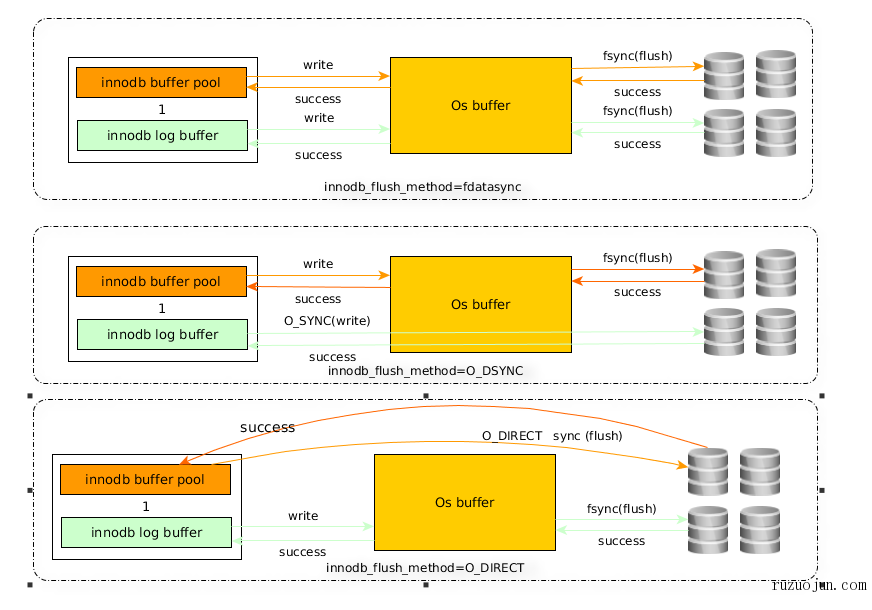MySQL Config--参数innodb_flush_method
延迟写
传统的UNIX实现在内核中设有缓冲区高速缓存或页面高速缓存,大多数磁盘I/O都通过缓冲进行。当将数据写入文件时,内核通常先将该数据复制到其中一个缓冲区中,如果该缓冲区尚未写满,则并不将其排入输出队列,而是等待其写满或者当内核需要重用该缓冲区以便存放其他磁盘块数据时,再将该缓冲排入输出队列,然后待其到达队首时,才进行实际的I/O操作。这种输出方式被称为延迟写(delayed write)(Bach [1986]第3章详细讨论了缓冲区高速缓存)。
"延迟写"减少了磁盘读写次数,但是却降低了文件内容的更新速度,使得欲写到文件中的数据在一段时间内并没有写到磁盘上。当系统发生故障时,这种延迟可能造成文件更新内容的丢失。为了保证磁盘上实际文件系统与缓冲区高速缓存中内容的一致性,UNIX系统提供了sync、fsync和fdatasync三个函数。
sync函数只是将所有修改过的块缓冲区排入写队列,无需等待写磁盘操作便返回。系统守护进程(update)会周期性(30秒)调用sync函数来刷新内存缓冲区。
fsync函数只对由文件描述符filedes指定的单一文件起作用,需要等待写磁盘操作结束后才返回,确保修改过的数据被写入到磁盘。fsync不但更新数据,还更新指定文件元数据(如修改时间和访问时间)。
fdatasync函数与fsync函数类似,但fdatasync函数只更新数据,而不更新指定文件的属性。
由于fsync函数除需要更新数据外,还需要更新文件元数据(metadata,包括文件大小/访问时间/修改时间等),因此fsync函数需要两次写,而fdatasync函数值需要一次写。
Unfortunately fsync() will alwaysalways initialize two write operations: one for the newly written data and another one in order to update the modification time stored in the inode.
If the modification time is not a part of the transaction concept fdatasync() can be used to avoid unnecessary inode disk write operations.
参数innodb_flush_method
参数innodb_flush_method有在Unix上有6个可选值:fsync/O_DSYNC/littlesync/nosync/O_DIRECT/O_DIRECT_NO_FSYNC,由于littlesync/nosync风险较高,常用的下面4种:
fsync:默认值,使用fsync()系统调用来刷新数据文件和日志文件
O_DSYNC:使用O_SYNC打开和刷新日志文件,使用fsync()刷新数据文件。(在很多UNIX版本上直接使用O_DSYNC会存在问题)
O_DIRECT:使用O_DIRECT打开数据文件,使用fsync()来刷新数据文件和日志文件。(O_DIRECT在大部分UNIX系统上可用)
O_DIRECT_NO_FSYNC:在Flush IO操作时使用O_DIRECT,但在每次write操作时跳过fsync()系统调用。(O_DIRECT_NO_FSYNC在MySQL 5.6.6版本引入,但不适合XFS和EXT4文件系统)
生产环境中使用innodb_flush_method=O_DIRECT
The innodb_flush_method options for Unix-like systems include: fsync: InnoDB uses the fsync() system call to flush both the data and log files. fsync is the default setting. O_DSYNC: InnoDB uses O_SYNC to open and flush the log files, and fsync() to flush the data files. InnoDB does not use O_DSYNC directly because there have been problems with it on many varieties of Unix. littlesync: This option is used for internal performance testing and is currently unsupported. Use at your own risk. nosync: This option is used for internal performance testing and is currently unsupported. Use at your own risk. O_DIRECT: InnoDB uses O_DIRECT (or directio() on Solaris) to open the data files, and uses fsync() to flush both the data and log files. This option is available on some GNU/Linux versions, FreeBSD, and Solaris. O_DIRECT_NO_FSYNC: InnoDB uses O_DIRECT during flushing I/O, but skips the fsync() system call after each write operation. This setting is not suitable for file systems such as XFS and EXT4, which require an fsync() system call to synchronize file system metadata changes. If you are not sure whether your file system requires an fsync() system call to synchronize file system metadata changes, use O_DIRECT instead. On storage devices with cache, data loss is possible if data files and redo log files reside on different storage devices, and a crash occurs before data file writes are flushed from the device cache. If you use or intend to use different storage devices for redo logs and data files, use O_DIRECT instead.
如果使用带缓存的RAID控制器,推荐使用O_DIRECT来避免操作系统和存储系统两次缓存。
如果使用SAN存储来存放数据文件和日志文件,对于读负载较高的存储系统,使用fsync()或O_DSYNC可能更快。

摘抄连接:
https://www.cnblogs.com/gomysql/p/3595806.html
https://www.cnblogs.com/bhlsheji/p/5222271.html
https://dev.mysql.com/doc/refman/5.6/en/innodb-parameters.html
MySQL Config--参数innodb_flush_method的更多相关文章
- mysql服务器参数
mysql服务器参数: 配置是从上往下读取,同一个参数项,后边的配置项会覆盖前边的配置项 mysql获取配置信息路径: 命令行参数 mysqld_safe --datadir=/data/sq ...
- mysql核心参数优化
MySQL数据库服务器配置CPU的优化内存的优化IO的优化连接的优化数据一致性的优化 1.描述back_log参数的作用? back_log = 500 要求 MySQL 能有的连接数量.当主要MyS ...
- 【查阅】mysql配置文件/参数文件重要参数笔录(my.cnf)
持续更新,积累自己对参数的理解 [1]my.cnf参数 [client]port = 3306socket = /mysql/data/3306/mysql.sockdefault-character ...
- Mysql性能参数优化
1.Max_connections (1)简介 Mysql的最大连接数,如果服务器的并发请求量比较大,可以调高这个值,当然这是要建立在机器能够支撑的情况下,因为如果连接数越来越多,mysql会为每个连 ...
- 1201MySQL配置文件mysql.ini参数详解
转自http://www.cnblogs.com/feichexia/archive/2012/11/27/mysqlconf.html my.ini(Linux系统下是my.cnf),当mysql服 ...
- (转)MySQL配置文件mysql.ini参数详解、MySQL性能优化
本文转自:http://www.cr173.com/html/18331_1.html my.ini(Linux系统下是my.cnf),当mysql服务器启动时它会读取这个文件,设置相关的运行环境参数 ...
- MySQL配置文件mysql.ini参数详解、MySQL性能优化
my.ini(Linux系统下是my.cnf),当mysql服务器启动时它会读取这个文件,设置相关的运行环境参数. my.ini分为两块:Client Section和Server Section. ...
- MySQL配置文件mysql.ini参数详解
my.ini(Linux系统下是my.cnf),当mysql服务器启动时它会读取这个文件,设置相关的运行环境参数. my.ini分为两块:Client Section和Server Section. ...
- 在Linux最大打开文件数限制下 MySQL 对参数的调整
http://www.actionsky.com/docs/archives/78 2016年4月7日 周文雅 目录 1 起因 2 说明 3 MySQL调整参数的方式 3.1 计算 request ...
随机推荐
- php+ajax无刷新分页原生ajax实现分页最简单完整实例-完整代码,
展示页面:index.html <html><script> function ajax_show() { // 获取当前页 var page =1; var xhr = ne ...
- ESA2GJK1DH1K微信小程序篇: 小程序连接MQTT简单的Demo
前言 这节让大家知道小程序是怎么连接的MQTT 其实,小程序就是网页实现MQTT 使用的是下面这个包 新建一个工程 一,把包放到util里面 二,编写连接函数 三,调用连接函数 订阅主题显示接收的消息 ...
- 洛谷 P4427
传送门 洛谷P4427 题意: 给你一个数,然后让你求这两个数之间的点的深度的k次方和. #思路: 很容易想到lca.因为lca可以说是求树上两个点的距离的好方法.而且lca还能遍历每一个点. 然后我 ...
- flex布局整理以及demo
flex: 概念: flex容器: display:flex flex项: 轴:水平的主轴.垂直的交叉轴 容器的属性: 1. flex-direction(决定主轴的方向.即项目的排列方向) 1.1 ...
- docker 部署 jenkins
建议使用的Docker映像是jenkinsci/blueocean image(来自 the Docker Hub repository). 该镜像包含当前的长期支持 (LTS) 的Jenkins版本 ...
- libevent笔记3:evbuffer
evbuffer 之前提到bufferevent结构体提供两个缓存区用来为读写提供缓存,并自动进行IO操作.这两个缓存区是使用Libevent中的evbuffer实现的,同样,Libevent中也提供 ...
- IDEA中,使用maven-可视化-下载jar包的source和javadoc
需求:想看jar包的源码和文档注释 操作:在Idea的右侧Maven窗口,选中一个Module,然后展开Dependencies|,选中一个依赖包,按住鼠标右键单击,选择Download Source ...
- .net core使用AutoMapper
AutoMapper文档:http://docs.automapper.org/en/stable/The-MyGet-build.html 新的版本抛弃了静态API方法,我们将使用依赖注入来完成. ...
- TreeMap源码分析1
二叉树他们都需要满足一个基本性质--即树中的任何节点的值大于它的左子节点,且小于它的右子节点.按照这个基本性质使得树的检索效率大大提高.我们知道在生成二叉树的过程是非常容易失衡的,最坏的情况就是一边倒 ...
- Oulipo 子串查找
题目描述 思路 使用哈希值表示较长串的子串的值,直接比较哈希值是否相等 代码 #include <cstdio> #include <cstring> using namesp ...
